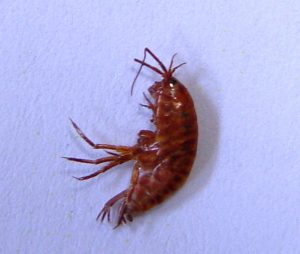 These creatures are actually terrestrial amphipods which belong to an order of crustacea. They look very similar to tiny shrimp therefore they were given the common name of lawn shrimp.
These creatures are actually terrestrial amphipods which belong to an order of crustacea. They look very similar to tiny shrimp therefore they were given the common name of lawn shrimp.
Most amphipods live in salt and fresh water but there are a few terrestrial forms. Even though these terrestrial forms live in our landscapes, they still require a moist habitat.
The color of terrestrial species varies from pale brown to greenish to brownish black when alive, but they often turn pink to red when they die. Most amphipods are scavengers feeding off mold which can be found in the mulched areas of our flower beds and shrubbery.
Terrestrial amphipods live on the surface (top 1/2 inch) of mulch and moist ground. After rains, large numbers of amphipods can migrate into garages or under the doors of houses. When this occurs, they quickly die as they do not have the protective covering (exoskeleton) of crustaceans or insects. Because they lack an exoskeleton their bodies quickly lose too much moisture and they die. However, they come into our homes and garages after heavy rains because their bodies will take on too much water and it can also kill them.
Most species are active at night. Since you found large numbers in the garage already dead, it would be best to sweep or vacuum them up. If you find them in the house, be sure to check the weather stripping around doorways. Since terrestrial lawn shrimp do not transmit diseases nor do they destroy any plant material it is best to leave them alone. In addition, there are no labeled insecticidal recommendations for control. Think of them more as a nuisance rather than a real pest. For more complete information, take time to look over the UF/IFAS publication titled, “Terrestrial Amphipods or Lawn Shrimp” at https://edis.ifas.ufl.edu/in377
 6
6
